“The Alternate”
Written by Jim Trombetta and Bill Dial
Directed by David Carson
Season 2, Episode 12
Production episode 40512-432
Original air date: January 9, 1994
Stardate: unknown
Station log: Quark is trying to sell the vacuum-desiccated remains of the great Ferengi Plegg—except, as Odo gleefully reveals to Quark, Plegg is still alive. Quark insists he’s the victim here, having been sold fake Plegg.
Before the conversation can continue, Dr. Mora Pol—the Bajoran scientist who “raised” Odo—enters the bar. It’s a tense reunion, as Odo isn’t really all that happy to see Mora. It doesn’t help that Mora starts in with all sorts of patronizing comments and annoying questions (“Haven’t quite managed the ears yet, have you?”). While Odo reluctantly admits that he misses the work they did together, though he doesn’t miss the atmosphere of Mora’s lab in the slightest.
A Bajoran science probe has discovered DNA patterns on a planet near the wormhole in the Gamma Quadrant that are similar to Odo’s. Mora has come to the station to request a runabout to investigate further.
Sisko approves, sending Mora, Odo, Dax, and another Bajoran scientist, Dr. Weld, through the wormhole. Mora tells Dax about Odo’s early days (Odo’s attempts to contribute to the conversation are, at the same time, encouraged verbally by Mora, but also discouraged by his constant interruptions and corrections.)
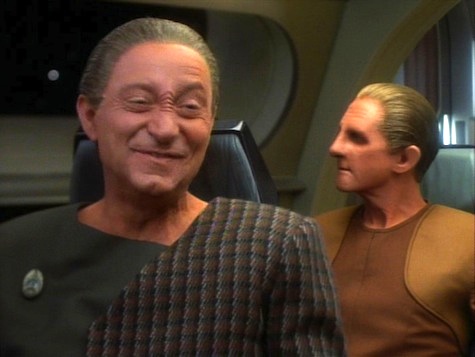
They beam down to the planet, into a set of ruins. There’s a monolith in the center, the only part that’s intact, with some markings. Odo doesn’t recognize it, but Dax transports it back to the runabout. Weld finds a biological sample that may be related to Odo, which he puts in a sample case. An earthquake then hits, the tremors releasing some gas from underground incapacitating everyone save for Odo. They return to the station, where Mora, Dax, and Weld are kept—the two Bajorans are unconscious from the gas, though Dax is doing better.
O’Brien has had to put the biological sample in a larger container, as it keeps multiplying.
In the middle of the night, the science lab has been trashed, and there’s no sign of the biological sample. It looks like it exploded out of the sample case and took most of the lab with it.
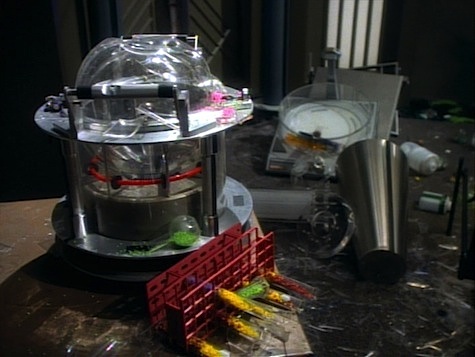
Mora awakens, and wants to help with the investigation, but he’s too ill—in fact, he falls back asleep in mid-conversation.
O’Brien is crawling around the ventilation systems, which appears to be the way the entity got out. He tracks a strange noise and finds a puddle of goo, which appears to be the now-dead life-form. Bashir and Dax analyze it, and conclude that it just couldn’t survive in the station’s atmosphere. After Dax leaves the infirmary, Bashir hears an odd noise, similar to the one O’Brien heard, then is attacked by a shape-changing life form, which escapes through the vent.
Mora and Dax look at the samples left behind by whatever attacked Bashir. It isn’t the same as any of the biological samples they brought back from the Gamma Quadrant, though they are related at a basic level. When Dax calls up the DNA of the residue left of the thing that attacked Bashir, Mora recognizes it as Odo’s DNA. But Mora doesn’t tell Dax this—he does tell Odo. The attacks both happened during Odo’s regeneration cycle. Mora insists that he not go to Bashir or Dax, that Mora himself is the only one who can help Odo—anyone else will imprison him or put him in a zoo. Odo recognizes this as a transparent attempt to get Odo to go back to the science center with Mora, but before the argument can continue, Odo starts to melt and change and buggers off. Mora goes to Ops and hypothesizes that the gas from the planet has affected Odo in such a way that he becomes a different personality—one that may have hostile intentions toward Mora.
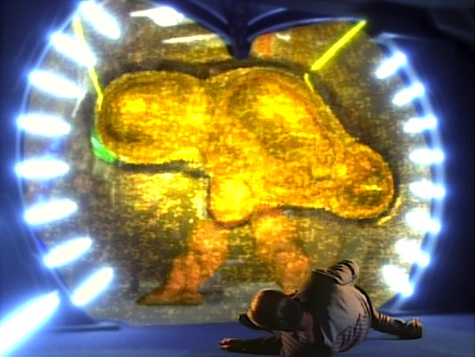
O’Brien is able to lure the Odo monster to the Promenade, where they’re using Mora as bait to get him in a force field. With Mora’s help, Bashir is able to remove all traces of the gas from his cellular structure, which should solve the problem. Odo apologizes to Mora, and Mora in turn apologizes right back. Mora also asks if he can once again be a small part of Odo’s life, and Odo agrees. It’s all very sweet.
Can’t we just reverse the polarity? The life-form is difficult for sensors to track because of its changing nature. Best of all, O’Brien has to actually reverse the polarity on the force fields in order to contain Odo.
The Sisko is of Bajor: Sisko has a conversation with Odo about how he dealt with his father’s illness. It’s strongly implied, though never directly stated, that it was a terminal illness, the second time that Sisko has made reference to his father in a manner that implies that he’s dead. Luckily, these references were non-specific enough that Joseph Sisko could show up in “Homefront.”
Sisko also has a hilarious conversation with Jake that every parent has had with their kid on the subject of homework: “When am I ever going to need [subject]?”
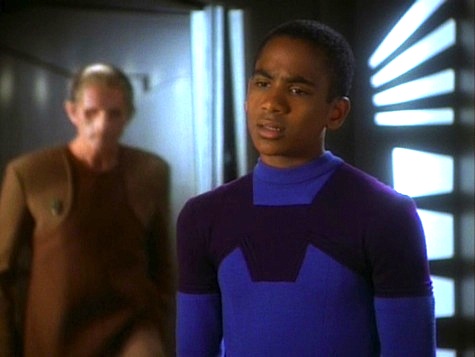
The slug in your belly: Dax’s idea of obeying doctor’s orders is to sneak out of the infirmary wearing a hospital gown that won’t close in the back. (Bashir hid her clothes, showing that he both understands and underestimates her.)
No sex, please, we’re Starfleet: Dax invites Bashir for a raktajino. Bashir gets his hopes up by asking “My replicator or yours?” and Dax slaps him down by saying that she meant on the Promenade. Bashir muses that Dax enjoys toying with him and that some day he’ll stop chasing her and that’ll show her!!! (It’s actually kind of sad, though “Starship Down” will reveal that Dax actually does enjoy his chasing her.)
Preservation of mass and energy is for wimps: Mora treats Odo like an experiment and a son in about equal measures. The latter part would appear to be different from how he treated Odo in the past, since Odo looks gobsmacked when Mora tells him that he’s proud of Odo’s accomplishments.
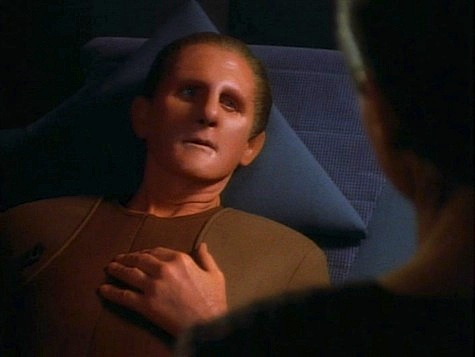
Keep your ears open: “I am merely a businessman. It would take an orator with the skills of the late, great Plegg himself to sing the praises of the late, great Plegg.”
Quark’s eulogy.
Welcome aboard: James Sloyan makes his second Trek appearance as Dr. Mora, having previously played “Sub-lieutenant Citol” (really Admiral Jarok) on TNG’s “The Defector.” He’ll return later this season on TNG as “K’mtar” (really an adult Alexander) in “Firstborn,” and he’ll reprise the role of Mora in “The Begotten” in the fifth season; he’ll also play the title role in Voyager’s “Jetrel.”
Trivial matters: The original plan was to follow the same pattern as the casting of Dr. Noonien Soong in TNG’s “Brothers,” and having Rene Auberjonois also play Mora, but the much more extensive makeup required for Odo made that impractical in the time. However, Sloyan was given a hairstyle that matches Odo, thus matching what Odo told Lwaxana in “The Forsaken.”
“Necessary Evil” established that Odo left the Bajoran Science Center in a huff and he didn’t speak particularly highly of the scientist who worked with him, which this episode develops nicely.
A monolith identical to that found in this episode will be seen on the Founders’ homeworld in “The Search, Part II,” the episode that identifies Odo’s origins.
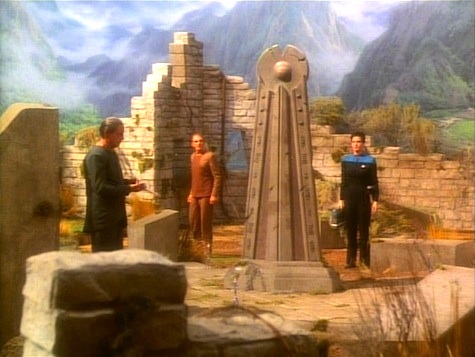
This is the last small-screen Star Trek story to be directed by David Carson, who will next direct the feature film Star Trek Generations.
Mora’s early history with Odo is detailed in the Terok Nor novels Night of the Wolves and Dawn of the Eagles by S.D. Perry & Britta Dennison. Judith & Garfield Reeves-Stevens used Mora as a mouthpiece to come up with a technobabble explanation for some of the more scientifically ridiculous aspects of Odo’s shapechanging in their Millennium trilogy.
Walk with the Prophets: “What makes you think I trust you?” The parts of this episode that show Odo and Mora interacting are excellent. Mora is, bluntly, a prick, and James Sloyan plays him magnificently, with his constant correcting of Odo, insisting on an almost pathological precision of language that jumps over the border to pedantic. Odo’s frustration with him is palpable and you can understand why he ran screaming from being stuck in a building with this guy. Mora’s admission to Dax that he was wrong about Odo being able to survive on his own seems like a revelation, but then he tries to manipulate Odo into coming back with him rather than tell his comrades that he’s the big scary monster.
The problem is that the plot surrounding this nifty character stuff is spectacularly uninteresting and thin. The suspense of finding the big scary monster falls totally flat, there are a lot of very nice character bits that feel like filler (Sisko and Jake on Klingon opera, O’Brien talking about how he characterizes his day to Keiko, Bashir soliloquizing about his pursuit of Dax), and ultimately there’s a giant sense of meh about the whole thing.
Meeting Mora provides some excellent insight into the already-complex character of Odo, but it really needed a story to go with it. It also needed a better ending, as Odo’s reconciliation with Mora at the end is no more convincing than Riker’s reconciliation with his father in “The Icarus Factor” on TNG. Like Kyle Riker, Mora isn’t any less a prick by episode’s end, and their hearts-and-flowers resolution strains credulity (even more so from the much-crankier Odo).
Warp factor rating: 3
Keith R.A. DeCandido’s latest book is Ragnarok and Roll: Tales of Cassie Zukav, Weirdness Magnet, a collection of urban fantasy short stories taking place in Key West, Florida. One of the stories is the three-part “Cayo Hueso,” all three parts of which will be available for 99 cents each. Part 1 is live now for Nook and Kindle, with Part 2 coming this week and Part 3 next week. Another story is “Undine the Boardwalk,” which you can read an excerpt of right on this web site. Folks in the New York area are invited to either or both of the launch parties next week: at the SoHo Gallery for Digital Art tonight and/or at Singularity & Co. on Friday the 23rd. Win a free autographed copy of the book by commenting on this post here on Tor.com.










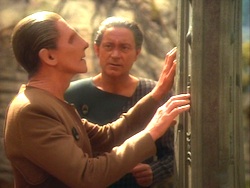
One of my biggest peeves about this episode was the beaming up of the monolith. I saw no good reason for that act of defilement of a set of ruins. They’d already determined that there wasn’t any machinery inside the monolith–its only interesting facet was the writing on its surface and possibly its shape. The monolith could have been holographically imaged and they would have gotten just as much from it as they did by removing it from the site. Now, I am no archaeologist, but this lone act seemed rather abhorrent to me. I might have forgiven it had the monolith had some greater purpose…but as it was I just found the whole thing rather irresponsible.
Mora will be given a more sympathetic treatment in his second appearance, when we get more details of their life together. Even here, we only get Odo’s perspective, and despite Mora’s annoying character traits, you could just as easily believe that Odo is being the ungrateful prick and exaggerating how badly he was treated. I didn’t see Mora’s transparent attempt to get Odo to go back to the science center as necessarily devious. Continuing the research was part of the reason, but Mora doesn’t know the people on DS9 or how much they care about Odo. For all he knows they really would imprison him, and he’s arrogant enough to think that Odo would be better off with him than anywhere else.
I was totally confused by the technobabble plot and still not sure exactly what happened. Why did the gas affect Odo that way? Did he break the specimen out? What answers does this give us about his species and that planet? What is the monolith exactly? Why didn’t they go back? I did like the special effect of Monster-Odo inside the force field.
As krad says, the Odo-Mora interactions are generally pretty good, but there’s absolutely nothing to go along with it. Apparently, the original concept was “What if a shapeshifter had multiple personality syndrome?” Potentially interesting, but handled rather badly. We get some really weak technobabble as a cause and even worse technobabble as a cure as a means of exploring the question.
The FX director was also very unhappy with the amount of screentime the “monster” got. His argument was that only brief flashes and leaving things up to the viewers’ imagination would be more effective. He cited Alien, where the creature has a ridiculously short amount of screen time prior to the final conflict and only bits and glimpses are seen.
And FossMaNo1 @1 is also right about the monolith. Terrible method, although no one on the mission was an archaeologist. Still, at least Dax should have known better.
Not much to add. Decent character stuff with Odo and Mora, but a weak danger/sci-fi plot and a mediocre “monster” story. I didn’t care for the FX of the Odo-creature either. Also, nothing here was really followed up or integrated with later Changeling lore. The obelisk prop being reused doesn’t really count, since it wasn’t explained.
About removing the obelisk, is that so horrible if it’s a dead planet and there are no natives to care about the site? Or is it an issue of archaeological technique, removing the artifact from its context before it’s been fully studied?
The obelisk – there are both archaeological and cultural objections.
Archaeologically – there is no reason to remove it, they can study its scans just as well. And they don’t know what damage its removal might do to the structure longterm or how well it will survive being in a ship.
Culturally – Just because there is noone on the planet, doesn’t mean the species who made it isn’t still around somewhere – in fact, we later learn that it is.
The obelisk is a red herring. Notice how the camera ominously pans across it once or twice when its aboard the station, as if trying to get us to think that the obelisk is somehow the one behind the attacks.
I’d actually rate this one higher. I really like the Odo/Mora confrontation that leads to Odo’s big freakout, and the “monster movie” vibe during the final act is a lot of fun. (If Odo fought the Gorn, who would win?) Plus, I didn’t see the ending as Odo and Mora reconciling, but more like making the first steps toward reconciling.
@6, Always bet on Odo.
@5: Do we actually know the Changelings built the obelisks? The reappearance of the obelisk on their homeworld implies that, but it was never confirmed. And would they really value material artifacts as anything more than shapes to imitate? Like I said, the ideas in this episode were never really followed up on, so it’s kind of an awkward fit to reconcile this with what we later learned of the Changelings. And it would be a hell of a coincidence if this happened to have been their original homeworld or something.
Reading the recap, I initially thought the name Mora belonged to a female.
Later in the recap, Mora tries to manipulate Odo into returning with him, then failing, goes to Ops and hypothesizes that the gas made Odo want to hurt him. Reading this made me think that Mora was trying to manipulate Ops into helping him get Odo, but since it’s actually true that Odo wants to hurt him, and Mora’s trying to get Odo to come with him, it makes Mora sound really, really dumb.
@8: Perhaps the Changelings abandoned the planet because the gas made them crazy. In which case the Federation should have gone back and tried to harvest and find a use for the gas in the war. Pump the gas into Federation HQ and just wait for the Changeling to go crazy when regenerating.
I think the removal of the obelisk was premature but not entirely bad. It’s not that much different, in my estimation, than bringing up objects from the Titanic or all of the graves being dug up in England after they found Richard III. We’re talking about an obelisk, but how many decades or centuries must one be buried before it’s not considered desecration of one’s grave?
I get that Odo was Mora’s most exciting discovery and obviously his work is important to him, but why does he not understand Odo doesn’t want to be a lab rat? Mora comes off much better in his second appearance. I can’t remember is this the episode where they explain what Odo’s name means in Cardassian which is basically nothing?
RobinM: No, that wasn’t this episode, it’s the third season’s “Heart of Stone” that will reveal the origin of Odo’s name.
—Keith R.A. DeCandido
I don’t know why Jake Sisko doesn’t like Klingon opera. I have Worf’s sonorous rendition of Aktuh and Maylota and play it in my shuttlecraft every chance I get. You have to be careful with it though – It’s like heavy metal. Before you know it you find yourself aggressively swooping around asteroids and blowing past the Warp 5 speed limit.
Hey! I learned something from this recap at least.
When I saw K’mtar (ie old Alexander) on my own recent TNG rewatch, I quickly recognized him as Jarok. The voice was so distinctive.
Just last week, I finished my DS9 rewatch (I’m not patient enough to wait for the recaps each week lol), and never once did I pick up on Dr Mora being the same actor. He was certainly familiar, but I just assumed it was because I remembered Dr Mora so clearly. As soon as I see that connection in print, though — it’s blindingly obvious. I don’t know how I missed it.
I got quite frustrated with this episode. It constantly hints that Odo was treated poorly by Mora while he was in the lab, and that’s where the instinctive reaction of monster-Odo comes from, but I don’t really see anything in their relationship that indicates this. All that I can work out is that Mora didn’t quite know how to reconcile his study of Odo as a scientific pursuit with Odo’s development as a sentient being with his own wants and needs; obviously that would inspire resentment in Odo, but not necessarily homicidal mood-swings.
How much of this can be blamed on the mysterious Gamma Quadrant gas, anyway? The consensus of the main characters seemed to be “it was probably the gas, we got rid of it so let’s hope it doesn’t happen again!”, which is a little wishy-washy.
The denouement, where Odo and Mora reconcile, seems forced, in a “oh no there’s only two minutes left in the episode” kind of way. Ideally we’d have had a more intimate conversation between them, where they hash out their feelings regarding each other, instead of “Bye, let’s keep in touch!” This will happen eventually, in “The Begotten” a few seasons away, so I’ll forgive this episode that much.
In general, I always thought that Odo was never properly developed as a character. I always wanted more Odo and more Kira. I’m left with the conclusion that there were too many characters on the show to handle them properly.
Keith, I knew at some point I would thorougly disagree with you. I loved this episode. I didn’t find Mora to be a “prick” at all. If that was what the writers were going for, the awesomeness that is James Sloyan portrayed Mora as a typical overbearing parent who is proud of his child and is bombastic at expressing that pride. I found Mora enjoyable in that vein, and of course James Sloyan plays it perfectly.
The story here is quite substantive IMO, and the overall suspense is palpable, as you don’t know what the “monster” is. And while I agree Kyle and Will Riker patching things up was rather unconvincing, here Odo and Mora building a bridge is quite convincing, and got a tear from me (I admit that freely).
Man, this particular DVD is kind of a let down. Now, full disclosure, when we watched this one I was pretty tired and falling asleep. So, I might have missed a few things.
1)I agree with those who found taking the artifact was a bit unseemly – they might have stated that there was nothing left on that planet and it was uninhabited, but even if it wasn’t – for all we know, it’s a place of pilgramage from other still populated planets. And the context of the other structures in the area could also be important in its study. In fact, I totally didn’t get the earthquake was an earthquake, I thought it was some kind of Indiana Jones style punishment triggered by removing the artifact (I told you, I was a bit out of it)!
2)I found the end really quite creepy. I DID really enjoy Dr. Mora’s performance, but I did not at all buy the patching up scene at the end. Because, either he did something really horrible that is causing Odo to have this rage personality, in which case it’s way creepy for him to be all ‘I still want to be a part of your life’, and for Odo to be all ‘okay, that’s nice’. OR, whatever conflicts they had did not justify this homicidal rage monster Odo. The whole thing just struck me as weird.
3)God, Bashir, STOP BEING THAT GUY. I think I’m in a minority, but I just never have been that into being ‘chased’ or pursued by men if I haven’t indicated that I enjoy or want them to pursue me (I’m fine with taking a risk the first few times, to test out the waters, but after that, lay off!). The more they pursued me, the more uncomfortable I felt, sometimes to the point where I felt vaguely uneasy/threatened and did not want to be around the person in ANY context at all. And Bashir definitely sets those bells off in my head (or would if somebody acted like that towards me). Maybe my triggers are a bit more sensitive than most women, though. Not that I had this problem that frequently, heh – but enough that I noticed the pattern. And the man I married, it should be noted, seemed to understand this. I wasn’t interested at the time, let him know, he backed off, we stayed friends, and then much later realized I was totally in love and we got married about 5 years ago, and now here we are, with two adorable boys and posting on Tor.com about DS9 together. Happy endings all around!
I also thought the obelisk was a booby trap, as the minute they removed it, the ground started shaking a la Indiana Jones.
@17 I haven’t seen much of this series, but at this point in the show, I would say that Kira and Odo are the most developed charcters on the show (except maybe Quark). Dax and Bashir are the odd characters out at the moment (and O’Brien hasn’t gotten much play really, but he benefits from all those recurring character years on TNG). In the two episodes revolving around Dax so far, one had her silent for most of the episode (Dax) and the other had her unconscious for much of the show (Invasive Procedures). I can only think of one Bashir-centric episode (The Passenger), and he was possessed for the whole thing. So far Bashir’s biggest episodes have been more about Garak.
On the other hand, Kira had Duet and Progress, arguably the two best episodes of the first season, and got a lot of play in the three-part season premiere, and she benefits not insignificantly from how centered on Bajroan and Cardassian politics the show is, even when she’s not the main player in the episode. Odo has had at least four episodes primarily centered on him (A Man Alone, The Vortex, Necessary Evil, and this one). The problem is that 3 of these epsiodes were pretty bad, but at least Odo got to be himself in all of them.
Like I said, this is just where I feel like the charcters are at this point. I’m sorry to hear it if Odo and Kira fall to the wayside, though I’m anxious to see the other charcters, especially Dax and Bashir, developed more.
I’d rate this one a bit higher, mostly because of the stellar performance by Rene Auberjonois. I’d categorize Dr. Mora less as a prick and more as clueless — clueless to the fact that Odo has developed, grown as a person, created his own life. Mora only knew Odo at the earliest stages of his development (or really, his adaptation to humanoids). Seen in that light, I feel that his attitude is understandable – like a father with a first grader who is unaware that the child has grown up. (Also: I kept hearing Dr. Moreaux, which was really confusing.) The episode has huge problems, to be sure, but I’d rate it maybe a 5 or 6.
I thought this episode was decent. Pretty entertaining but I agree it had a lot of filler in it. I don’t think Odo hated Dr. Mora; I think he was very conflicted about him. He seemed grateful that Mora took him in, educated him, and helped him try to find a sense of identity, but also was very annoyed by his personality. The gas on the planet made him lose control of his emotions and his frustrations with him were greatly magnified.
The situation reminds me of teachers I had growing up whose personalities I can’t stand but I was still impressed with their knowledge and learned a lot from them. You feel like you can’t live with them but you can’t live without them. I’d never want to live with someone like them but I still recognize they helped develop me into the man I am today.
I think it’s a successful episode in the sense that the main focus is the relationship between Odo and Mora, and that’s done very well with some great acting from René. I totally agree with the fillery nature of some of the stuff, the O’Brien and Bashir monologue parts were really conspicuous. The Klingon opera part could be thought of in the same way, but honestly most of the Jake and Sisko scenes feel oddly kind of tacked on to me.
The thing is, I’ve watched dozens and dozens of episodes of all different flavours of Trek over the last few weeks and one thing I repeatedly find myself thinking is that just about none of the stories benefit from a 45 minute runtime. Here in the UK most TV episodes are half an hour in length. 45 minute runtimes aren’t exactly rare but they’re not the standard. From this viewpoint, where 45 mins seems like an “upgrade” that a series is given if it really needs it, Star Trek seems burdened with that length. There’s a plodding, leaden pace to so much of what I’ve seen so far. I often find myself feeling that the story’s due to wrap up, check the timer, and we’re at about 28 minutes. Either that or they have painfully slow introductory stages.
@24/matroska: As a rule, American drama/action shows are made for a 1-hour timeslot while sitcoms are made for half-hours. It used to be that there were few enough commercials in an hour that a “1-hour” show was actually 52-55 minutes long. But by the time of TNG, DS9, etc., the commercials had encroached so much on the story time than an “hourlong” show was down to 43 minutes, including the title sequences.
And I think part of the reason so many British shows are 45 minutes long is so that they can potentially be sold in the US, or to commercial networks in other countries. Kinda like how ’60s Doctor Who episodes always had a fade to black halfway through so that commercials could be added by overseas broadcasters.
Until last night, I hadn’t watched this episode since its original airing. I also would’ve ranked it higher because I could relate to Odo’s relationship with Mora, having experienced something similar with one of my parents. The monster story was just serviceable, but it didn’t drag the episode down for me. Between this one and “Aquiel” though, maybe shapeshifter mysteries need a looong hiatus.
@25 CLB – I’m reminded of the story about the Happy Days pilot being several minutes shorter than a typical episode in order to impress the suits with its pacing. I’ve always wondered if that’s apocryphal. It seems like someone would’ve checked their watch.
I quite liked this episode. It’s nothing to get terribly excited about but it has plenty of good moments. It has a cool little monster story which owes quite a bit to Forbidden Planet and the Monster from the Id manifesting from Dr. Morbius’ subconscious mind.
Like several other commenters, I don’t think that Dr. Mora is a prick, though he does have a few rough edges. He is often condescending and overbearing towards Odo even if he doesn’t mean to be. However, he is genuinely very fond of Odo and throughout the episode he sees that he has grown as a person and as such gains a new respect for him. I agree with RMS81 that Odo felt very conflicted towards Dr. Mora as opposed to hating him outright. I found their reconciliation at the end of the episode to be entirely convincing, to be honest. Kyle Riker was indeed a massive prick though and his reconciliation with his son fell flat as a result.
James Sloyan gives an excellent performance, as he does in all of his other Star Trek appearances, but I can’t help but wonder how Rene Auberjonois would have played the role if that idea had proven to be more practical.
Coming late to the discussion but I just watched this episode last night.
I don’t think anyone mentioned this but I noticed that Mora and his assistant didn’t wear earrings. I assume this was a subtle way of showing that they were atheistic scientists. I don’t recall seeing any other Bajorans without earrings, even the technically minded ones in Ops.
@28/CathWren: Contrary to the rhetoric of certain religious extremists, there is no automatic correlation between being a scientist and being an atheist. Many great scientists throughout history have been religious, and there have been many eras and cultures in which religious institutions have fostered science and scholarship rather than seeking to suppress it. For instance, contrary to Enlightenment-era myths, the medieval Catholic Church strove to preserve classical scholarly texts as much as possible, and of course Islamic culture made considerable advances in astronomy, mathematics, anatomy, medicine, and so forth during the Middle Ages.
In particular, there’s no reason to think that Bajoran religion would see itself as incompatible with science, except from the perspective of extremists like Winn. After all, their gods are provably real life forms, so they’d have every reason to see science and faith as mutually compatible rather than contradictory. And the anti-science attitudes of factions like Winn’s (or extremist religious groups today) has less to do with religious faith than it does about political and social power, in that keeping people ignorant and untrained in critical thinking makes them easier to deceive and control.
Perhaps the lack of earrings was simply a costuming oversight. Or maybe, since the idea was that Odo modeled himself on Mora’s appearance, they wanted Mora to be as bling-free as Odo.
@29CLB: I knew someone would read that as my thinking scientists were all atheists. I know that isn’t the case. I merely meant that those particular scientists were atheists. I, myself, have no problems reconciling my faith with science and I know others who feel as I do.
I find it hard to believe that the costume department would “forget” the earrings when I’ve never even seen background Bajorans without their earrings (though, of course, since they are in the background, I could have missed them). But I believe the lack of earrings was deliberate on both characters. Though I’ll admit that continuity errors do occur. There was a scene a couple of episodes ago where Sisko’s comm badge had been removed, then showed up and then disappeared again. But not for a whole episode.
As already pointed out in the first comment, beaming up the monolith was completly unneccessary. If they want to examine it, they have to bring the equipment there. Even worse, in the end that monolith wasn’t even needed as a plot device. It was just moved because “it was in the way”.
One thing I asked myself, how does Odo’s combadge work? Is it shapeshifted? It has to be, because else it would have to fall down every time he shifts shapes. But then it would be impossible for Odo to use it as a communication device. It wouldn’t be a real badge…
@31: I’m guessing it’s a real combadge, and that in all or most cases, Odo is able to hide the badge in the interior of whatever form he’s taken.
I’m not an archeologist, but it seems to me in every movie I’ve seen that depicts or at least tries to depict archeology, the object of interest is always removed (hello Indiana Jones!). This episode just goes with that precedent. I’m not saying it’s right or wrong, just that it is what it is.
Also, I never got the impression that Dr. Mora was a prick. I felt he was more analogous to a workaholic parent, but who’s work just happened to be his own surrogate son. I think he genuinely cared for Odo, but was like a lot of parents who treat their adult kids as children.
Actually the cavalier way ST has handled archeology has always bothered me. Artifacts belong in museums so they can be studied. They don’t belong in private collections for the pleasure of one, or just a few, people. Picard’s collection, especially the item filled with the people inside which was very rare to be found complete, should have been turned over to the archology commission of their respective planets. As much as I would love to have genuine artifacts in my collection, I satisfied myself with replicas.
Surprised nobody noticed that Dr. Mora exclaims “Dear God!” at one point. Perhaps he’s a convert to Christianity and that’s why he doesn’t wear the earring?
@35/Jono: Christians aren’t the only people who say “Dear God!” It’s a common English expression that many people use simply to convey surprise or strong emotion, even if they’re not believers, or follow polytheistic faiths.
And even if he were a convert to a monotheistic religion, why assume Christianity?
@35/36: I agree with what CLB said. But what else is interesting is that in ‘The Alternate,’ Dr. Mora doesn’t have an earring and exclaims, “Dear God!” But then in ‘The Begotten,’ he has an earring, and exclaims, “By the Prophets!”
Who knows if the first episode was a continuity error and the second episode was an acknowledgment of that, or if the first episode was a conscious choice by the production team. However, in-universe, the discrepancies between both appearances by Mora can be explained in many different ways.
@37/Thierafhal: I figure it’s just that Bajoran customs were less standardized in season 1. Like how in “Ensign Ro” on TNG, Bajorans were called “Bajora” and the men wore their earrings on the opposite ear from the women (IIRC), but then DS9 standardized it that they all wore earrings on the same side unless they were Pah wraith cultists.
I like a lot of the episode but it’s hard to get past how culturally insensitive, contextually dubious with regard to further study, and — just practically speaking in terms of potential environmental ramifications — colossally stupid it is for them to beam that monolith off-planet. What if in some natural and/or technological fashion (perhaps a fusion of both) not immediately evident it’s been integrated into its surroundings? This is the Star Trek universe we’re talking about.
James Sloyan is yet again just gold, though, and René Auberjonois’ various, conflicted reactions to Mora as Odo shine even through the makeup.
Re customs and standards: Halfway into Season 2 and there’s still no uniformity on whether “Bajoran” is pronounced with a hard j (soft g) as in “judge” or with a soft (or French) j “zh” sound. I’m even still hearing “Bajor” with a stress on the second rather than first syllable at times.
@39/Arben: On the subject of pronunciation, it’s not unusual for different individuals to pronounce a proper name in different ways, even when directly conversing with each other. There may be only one correct way to pronounce it, but it’s more realistic if characters in fiction don’t always get everything correct.
Sometimes they get it wrong even when they should know better. I could forgive my high school physics teacher who said “Aristophanes” when he meant “Eratosthenes,” since that’s kind of a tricky one, but I was frustrated by the English teacher who insisted on pronouncing “Albert Camus” the American way, “AL-burt KAY-muss.”
@40. ChristopherLBennett — “but it’s more realistic if characters in fiction don’t always get everything correct”
I take your point but the conventions of TV fiction have me conditioned against such haphazard realism: Just as we don’t usually get characters with the same name in a discrete group unless it would be germane to the plot, counter to the probabilities in messy life, and the spelling of even unusual proper nouns tends to be jotted down correctly on the first try when relayed over the phone or comms, one doesn’t expect to hear varying pronunciations of a word beyond dialect — like Picard’s use of “sh” rather than “sk” in “schedule” or saying the name Gandhi in a flat nasal tone to rhyme with “candy” rather than “blondie”. That latter quirk, a rare flip of the norm in American vs. British English, I find, is also why Stewart has Picard say Lal’s name to rhyme with “pal” rather than “doll” even when she’s introduced aloud since he actually first came across her name in the script. When actors give us differing pronunciations of proper names or technobabble coinages it’s nearly always because they first spoke them to themselves off the page while learning dialogue and not due to some imagined relevant backstory.
@41/Arben: “When actors give us differing pronunciations of proper names or technobabble coinages it’s nearly always because they first spoke them to themselves off the page while learning dialogue and not due to some imagined relevant backstory.”
Does it matter why it happened? I’m just saying that if two characters pronounce the same name differently, that isn’t a credibility problem worth worrying about, because it’s something that happens often in real life. And yes, sometimes people even do it with names they’ve only heard spoken aloud, because people have their own phonetic expectations and habits and sometimes only catch the sound approximately.
Although, yes, there are cases where the two characters should pronounce something the same way and it’s incongruous when they don’t. There was a short-lived show in the ’80s called The Wizard, where David Rappaport played a genius inventor who gave up designing weapons to become a toymaker and then teamed up with a government agent to fight high-tech crime, as you do. There was an episode involving a teenage girl who’d been raised by wolves or something and didn’t speak English, and Rappaport’s character was trying to teach her to say “girl,” which he said in his Cockney accent as “gell, gell, gell.” And then the actress replied with “girl” in a distinctly American accent, which drove me crazy. Why didn’t the director catch that?